Influence of Coalescence on the Anisotropic Mechanical and Electrical Properties of Nickel Powder/Polydimethylsiloxane Composites
Abstract
:1. Introduction
2. Experimental
2.1. Materials and Sample Preparation
2.2. Characterization
3. Results and Discussion
4. Conclusions
Acknowledgments
Author Contributions
Conflicts of Interest
References
- Rybak, A.; Boiteux, G.; Melis, F.; Seytre, G. Conductive polymer composites based on metallic nanofiller as smart materials for current limiting devices. Compos. Sci. Technol. 2010, 70, 410–416. [Google Scholar] [CrossRef]
- Azar, N.S.; Pourfath, M. A Comprehensive study of transistors based on conductive polymer matrix composites. IEEE T. Electron. Dev. 2015, 62, 1584–1589. [Google Scholar] [CrossRef]
- Ma, C.G.; Xi, D.Y.; Liu, M. Epoxy resin/polyetherimide/carbon black conductive polymer composites with a double percolation structure by reaction-induced phase separation. J. Compos. Mater. 2013, 47, 1153–1160. [Google Scholar] [CrossRef]
- Singh, J.P.; Chu, H.Y.; Abell, J.; Tripp, R.A.; Zhao, Y.P. Flexible and mechanical strain resistant large area SERS active substrates. Nanoscale 2012, 4, 3410–3414. [Google Scholar] [CrossRef] [PubMed]
- Gonzalez, D.M.; Korstgens, V.; Yao, Y.; Song, L.; Santoro, G.; Roth, S.V.; Müller-Buschbaum, P. Improved power conversion efficiency of P3HT:PCBM organic solar cells by strong spin-orbit coupling-induced delayed fluorescence. Adv. Energy Mater. 2015, 5, 1401770. [Google Scholar]
- Kang, I.P.; Schulz, M.J.; Kim, J.H.; Shanov, V.; Shi, D.L. A carbon nanotube strain sensor for structural health monitoring. Smart Mater. Struct. 2006, 15, 737–748. [Google Scholar] [CrossRef]
- Laflamme, S.; Kollosche, M.; Connor, J.J.; Kofod, G. Robust flexible capacitive surface sensor for structural health monitoring applications. J. Eng. Mech. 2013, 139, 879–885. [Google Scholar] [CrossRef]
- Jang, S.H.; Yin, H.M. Effect of aligned ferromagnetic particles on strain sensitivity of multi-walled carbon nanotube/polydimethylsiloxane sensors. Appl. Phys. Let. 2015, 106, 141903. [Google Scholar] [CrossRef]
- Chang, P.C.; Flatau, A.; Liu, S.C. Review paper: Health monitoring of civil infrastructure. Struct. Health Monit. 2003, 2, 257–267. [Google Scholar] [CrossRef]
- Balageas, D. Introduction to Structural Health Monitoring. In Structural Health Monitoring; Balageas, D., Fritzen, C.P., Eds.; ISTE: London, UK, 2006. [Google Scholar]
- Choi, J.J.; Hahn, B.D.; Ryu, J.; Yoon, W.H.; Lee, B.K.; Park, D.S. Preparation and characterization of piezoelectric ceramic-polymer composite thick films by aerosol deposition for sensor application. Sens. Actuat. A-Phys. 2009, 153, 89–95. [Google Scholar] [CrossRef]
- Li, J.P.; Peng, T.Z.; Fang, C. Screen-printable sol-gel ceramic carbon composite pH sensor with a receptor zeolite. Anal. Chim. Acta 2002, 455, 53–60. [Google Scholar] [CrossRef]
- Qin, F.X.; Peng, H.X.; Tang, J.; Qin, L.C. Ferromagnetic microwires enabled polymer composites for sensing applications. Compos. Part A-Appl. Sci. Manuf. 2010, 41, 1823–1828. [Google Scholar] [CrossRef]
- Hu, N.; Karube, Y.; Arai, M.; Watanabe, T.; Yan, C.; Li, Y.; Liu, Y.; Fukunaga, H. Investigation on sensitivity of a polymer/carbon nanotube composite strain sensor. Carbon 2010, 48, 680–687. [Google Scholar] [CrossRef]
- Vemuru, S.M.; Wahi, R.; Nagarajaiah, S.; Ajayan, P.M. Strain sensing using a multiwalled carbon nanotube film. J. Strain. Anal. Eng. 2009, 44, 555–562. [Google Scholar] [CrossRef]
- Kanoun, O.; Muller, C.; Benchirouf, A.; Sanli, A.; Dinh, T.N.; Al-Hamry, A.; Bu, L.; Gerlach, C.; Bouhamed, A. Flexible carbon nanotube films for high performance strain sensors. Sensors 2014, 14, 10042–10071. [Google Scholar] [CrossRef] [PubMed]
- Park, Y.L.; Chen, B.R.; Wood, R.J. Design and fabrication of soft artificial skin using embedded microchannels and liquid conductors. IEEE Sens. J. 2012, 12, 2711–2718. [Google Scholar] [CrossRef]
- Fassler, A.; Majidi, C. Liquid-phase metal inclusions for a conductive polymer composite. Adv. Mater. 2015, 27, 1928–1932. [Google Scholar] [CrossRef] [PubMed]
- Shin, H.S.; Ryu, J.; Majidi, C.; Park, Y.L. Enhanced performance of microfluidic soft pressure sensors with embedded solid microspheres. J. Micromech Microeng. 2016, 26, 025011. [Google Scholar] [CrossRef]
- Chun, K.Y.; Oh, Y.; Rho, J.; Ahn, J.H.; Kim, Y.J.; Choi, H.R.; Baik, S. Highly conductive, printable and stretchable composite films of carbon nanotubes and silver. Nat. Nanotechnol. 2010, 5, 853–857. [Google Scholar] [CrossRef] [PubMed]
- Yamada, T.; Hayamizu, Y.; Yamamoto, Y.; Yomogida, Y.; Izadi-Najafabadi, A.; Futaba, D.N.; Hata, K. A stretchable carbon nanotube strain sensor for human-motion detection. Nat. Nanotechnol. 2011, 6, 296–301. [Google Scholar] [CrossRef] [PubMed]
- Yamaguchi, K.; Matsumoto, K.; Fujii, T. Magnetic-anisotropy by ferromagnetic particles alignment in a magnetic-field. J. Appl. Phys. 1990, 67, 4493–4495. [Google Scholar] [CrossRef]
- Park, C.; Robertson, R.E. Alignment of particles by an electric field. Mat. Sci. Eng. A-Struct. 1998, 257, 295–311. [Google Scholar] [CrossRef]
- Borzsonyi, T.; Szabo, B.; Wegner, S.; Harth, K.; Torok, J.; Somfai, E.; Bien, T.; Stannarius, R. Shear-induced alignment and dynamics of elongated granular particles. Phys. Rev. E 2012, 86, 051304. [Google Scholar]
- Shen, X.J.; Liu, Y.; Feng, Q.P.; Xiao, H.M.; Fu, S.Y.; Friedrich, K. Preparation and characterization of multifunctional free-standing Ni/epoxy composite films. Express Polym. Lett. 2012, 6, 903–913. [Google Scholar] [CrossRef]
- Zhu, L.; Xie, D.S.; Ma, J.; Shao, J.; Shen, X.Q. Fabrication of polydimethylsiloxane composites with nickel particles and nickel fibers and study of their magnetic properties. Smart Mater. Struct. 2013, 22, 45015–45021. [Google Scholar] [CrossRef]
- Park, B.J.; Fang, F.F.; Choi, H.J. Magnetorheology: Materials and application. Soft Matter 2010, 6, 5246–5253. [Google Scholar] [CrossRef]
- Song, P.; Peng, Z.J.; Yue, Y.L.; Zhang, H.; Zhang, Z.; Fan, Y.C. Mechanical properties of silicone composites reinforced with micron- and nano-sized magnetic particles. Express Polym. Lett. 2013, 7, 546–553. [Google Scholar] [CrossRef]
- Sun, L.; Keshoju, K.; Xing, H. Magnetic field mediated nanowire alignment in liquids for nanocomposite synthesis. Nanotechnology 2008, 19, 405603. [Google Scholar] [CrossRef] [PubMed]
- Steinert, B.W.; Dean, D.R. Magnetic field alignment and electrical properties of solution cast PET-carbon nanotube composite films. Polymer 2009, 50, 898–904. [Google Scholar] [CrossRef]
- Song, H.; Tan, M.Y.; Walker, T.W.; Jander, A.; Dhagat, P. Planar alignment of magnetic microdisks in composites using rotating fields. IEEE Trans. Mag. 2015, 51, 2802105. [Google Scholar]
- Kim, K.; Kim, M.; Kim, J.; Kim, J. Magnetic filler alignment of paramagnetic Fe3O4 coated SiC/epoxy composite for thermal conductivity improvement. Ceram. Int. 2015, 41, 12280–12287. [Google Scholar] [CrossRef]
- Kumar, A.; Khusid, B.; Qiu, Z.Y.; Acrivos, A. New electric-field-driven mesoscale phase transitions in polarized suspensions. Phys. Rev. Lett. 2005, 95, 258301. [Google Scholar] [CrossRef] [PubMed]
- Jang, S.H.; Yin, H.Y. Effective electrical conductivity of carbon nanotube-polymer composites: a simplified model and its validation. Mater. Res. Express 2015, 2, 045602. [Google Scholar] [CrossRef]
- ASTM D412. Standard Test Methods for Vulcanized Rubber and Thermoplastic Elastomers–Tension; ASTM International: West Conshohocken, PA, USA, 2013. [Google Scholar]
- Kang, T.G.; Hulsen, M.A.; den Toonder, J.M.J.; Anderson, P.D.; Meijer, H.E.H. A direct simulation method for flows with suspended paramagnetic particles. J. Comput. Phys. 2008, 227, 4441–4458. [Google Scholar] [CrossRef]
- Trohidou, K.N.; Kechrakos, D. Magnetization behaviour of small particle aggregates. J. Phys.: Condens. Matter. 1988, 10, L255–L258. [Google Scholar] [CrossRef]
- Chen, Y.; Guo, Y.; Batra, S.; Unsal, E.; Wang, E.; Wang, Y.; Cakmak, M. Large-scale R2R fabrication of piezoresistive films (Ni/PDMS) with enhanced through thickness electrical and thermal properties by applying a magnetic field. RSC Adv. 2015, 5, 92071–92079. [Google Scholar]
- Wang, M.S.; He, L.; Yin, Y.D. Magnetic field guided colloidal assembly. Mater. Today 2013, 16, 110–116. [Google Scholar] [CrossRef]
- Johnston, I.D.; McCluskey, D.K.; Tan, C.K.L.; Tracey, M.C. Mechanical characterization of bulk Sylgard 184 for microfluidics and microengineering. J. Micromech. Microeng. 2014, 24, 035017. [Google Scholar] [CrossRef]
- Mitescu, C.D.; Allain, M.; Guyon, E.; Clerc, J.P. Electrical conductivity of finite-size percolation networks. J. Phys. A: Math. Gen. 1982, 15, 2523–2531. [Google Scholar] [CrossRef]
- Karasek, L.; Meissner, B.; Asai, S.; Sumita, M. Percolation concept: polymer-filler gel formation, electrical conductivity and dynamic electrical properties of carbon-black-filled rubbers. Polym. J. 1996, 28, 121–126. [Google Scholar] [CrossRef]
- Zhu, L.J.; Cai, W.Z.; Gu, B.Q.; Tu, S.T. Tunneling percolation model of the electrical conductivity of particulate nanocomposites. Mod. Phys. Lett. B 2009, 23, 1273–1279. [Google Scholar] [CrossRef]
- Bruning, K.; Schneider, K.; Roth, S.V.; Heinrich, G. Kinetics of strain-induced crystallization in natural rubber studied by WAXD: dynamic and impact tensile experiments. Macromolecules 2012, 45, 7914–7919. [Google Scholar] [CrossRef]
- Yazdani, H.; Hatami, K.; Khosravi, E.; Harper, K.; Grady, B.P. Strain-sensitive conductivity of carbon black-filled PVC composites subjected to cyclic loading. Carbon 2014, 79, 393–405. [Google Scholar] [CrossRef]
- Mansour, S.A. Effect of extensional cyclic strain on the mechanical and physico-mechanical properties of PVC-NBR/graphite composites. Express Polym. Lett. 2008, 2, 836–845. [Google Scholar] [CrossRef]
- Bhagavatheswaran, E.S.; Parsekar, M.; Das, A.; Le, H.H.; Wiessner, S.; Stockelhuber, K.W.; Schmaucks, G.; Heinrich, G. Construction of an interconnected nanostructured carbon black network: development of highly stretchable and robust elastomeric conductors. J Phys. Chem. C 2015, 119, 21723–21731. [Google Scholar]
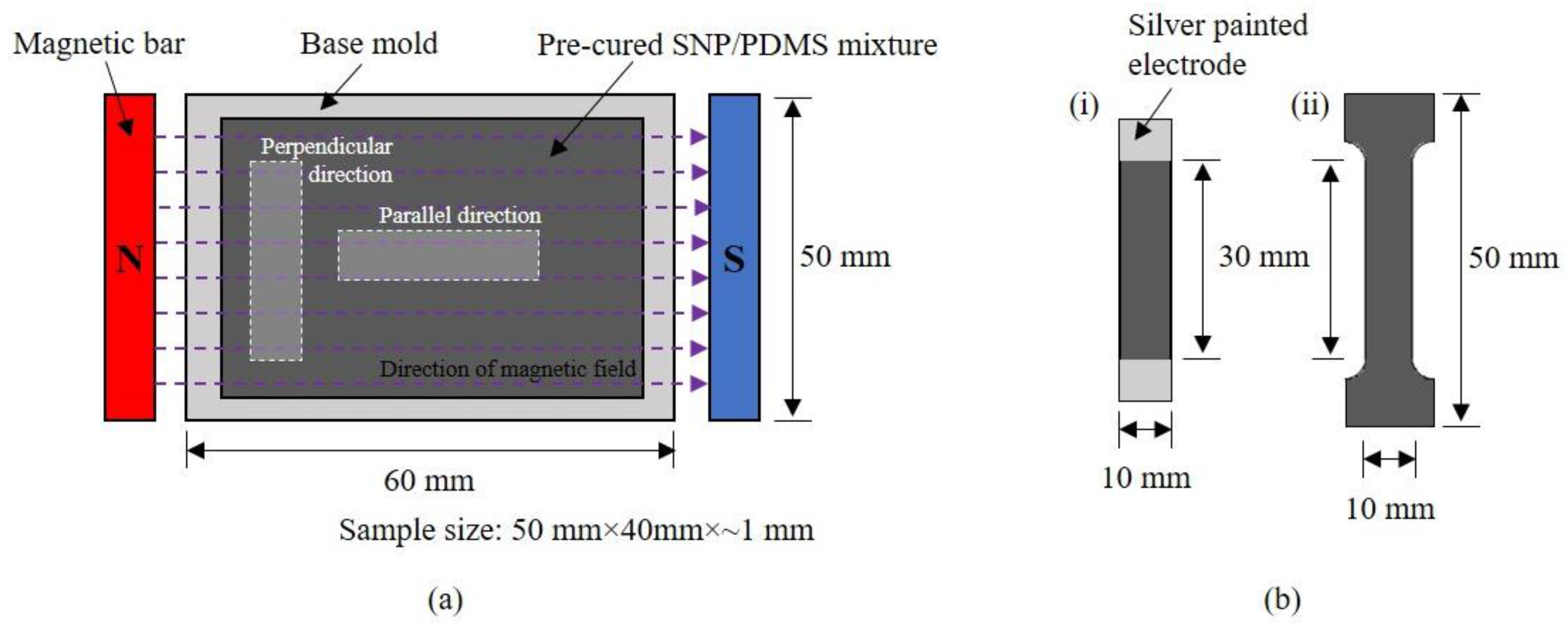
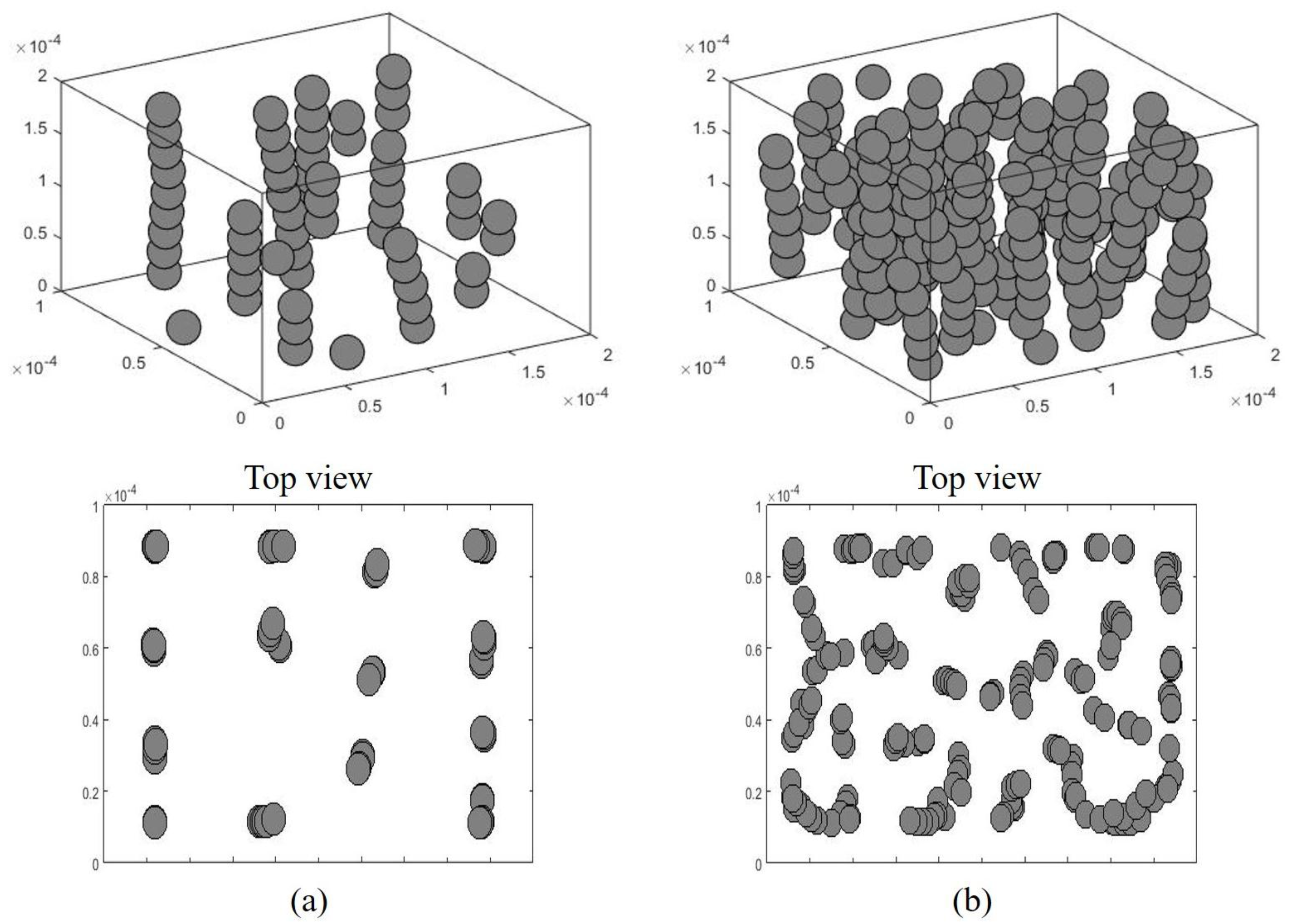
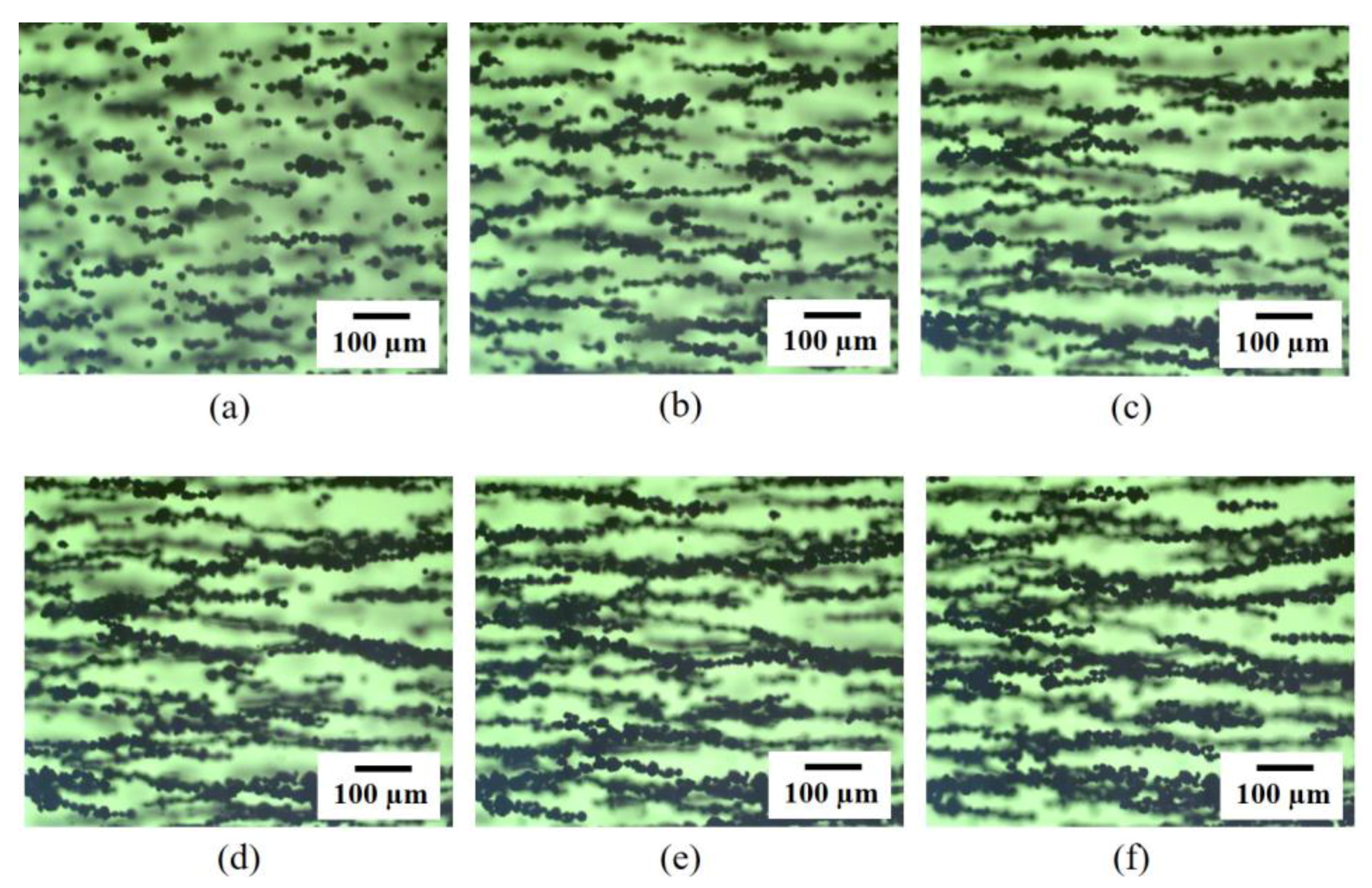
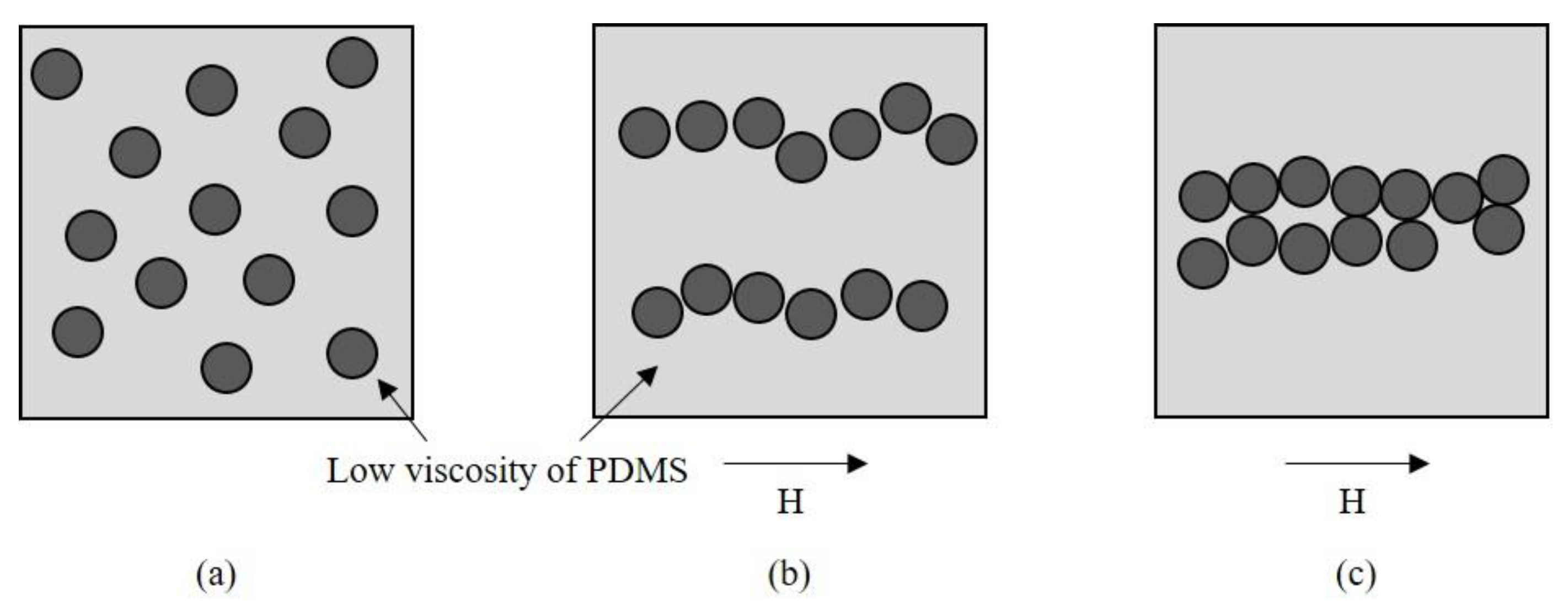
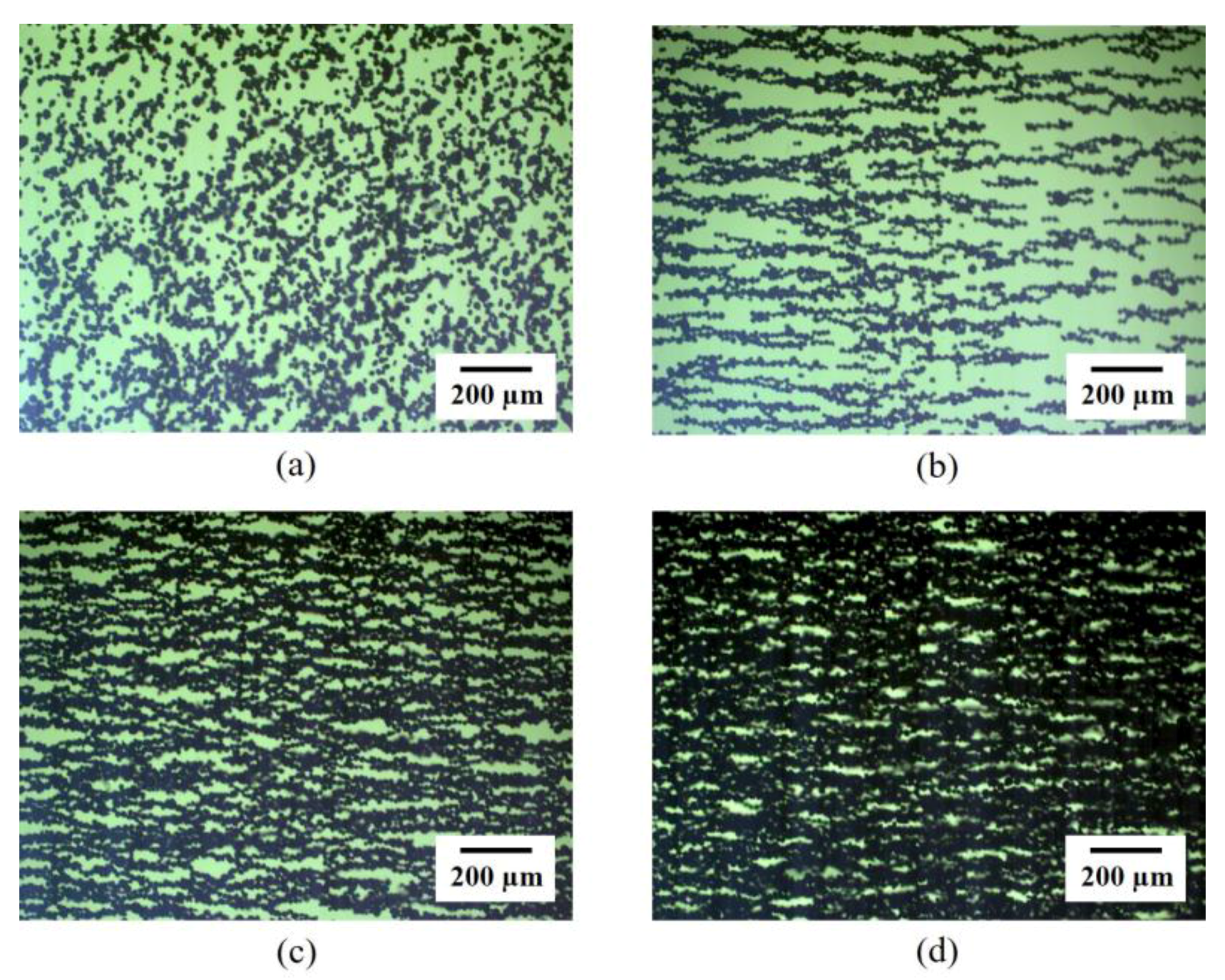
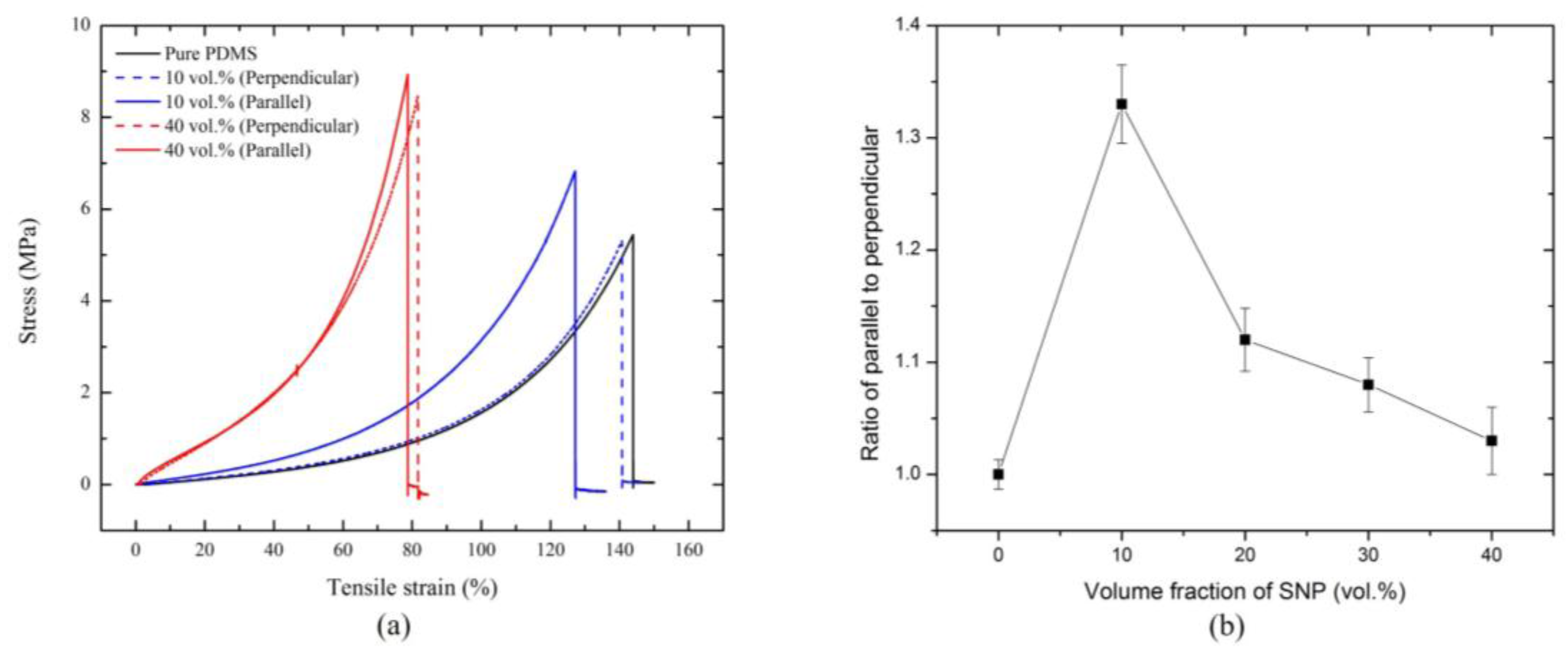
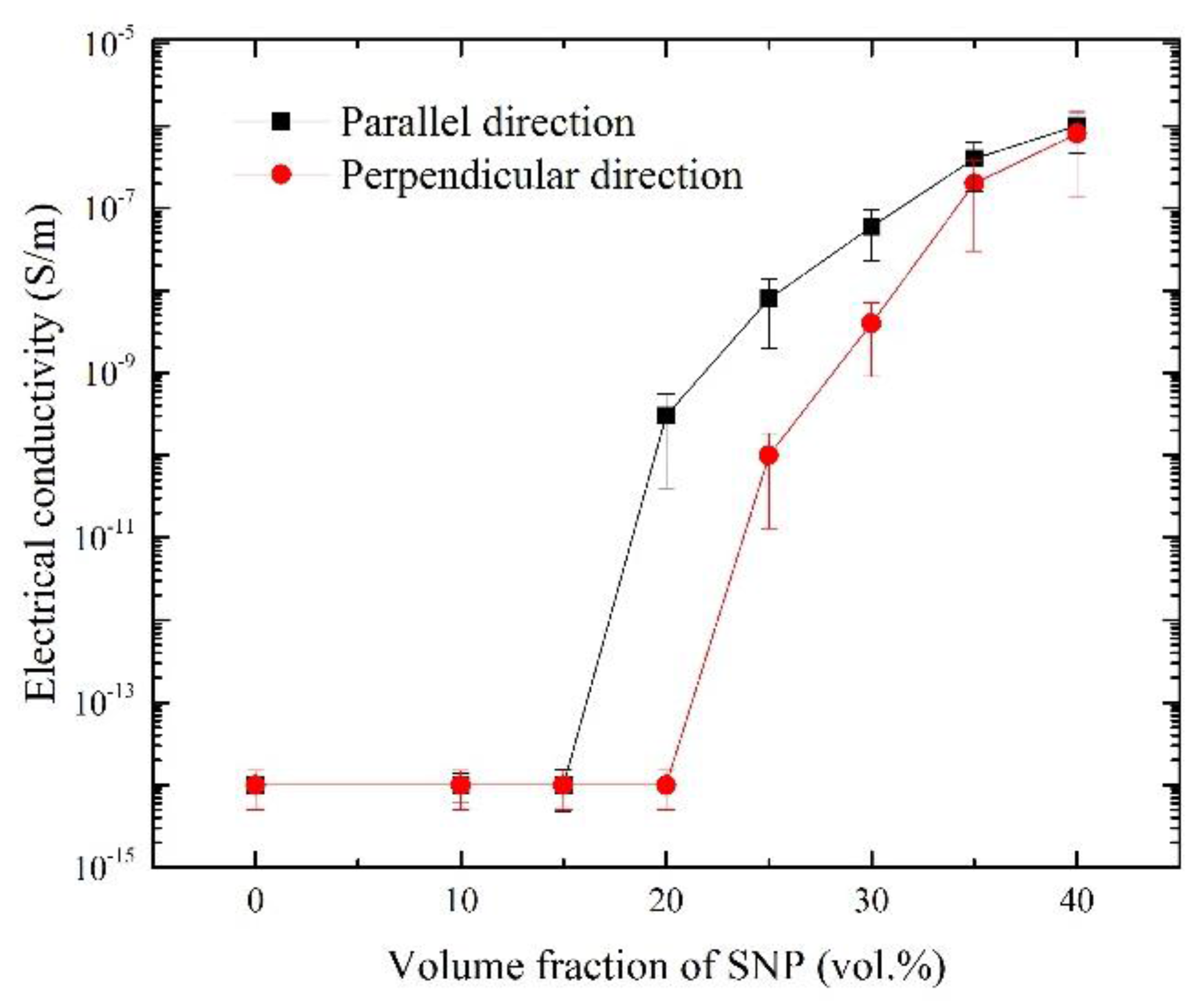
| Sample | Ultimate Tensile Strength (MPa) | Maximum Tensile Strain (%) |
|---|---|---|
| Pure PDMS | 5.39 ± 1.23 | 144 ± 9.3 |
| 10 vol. % (Perpendicular) | 5.11 ± 1.53 | 141 ± 10.2 |
| 10 vol. % (Parallel) | 6.78 ± 1.52 | 127 ± 9.1 |
| 20 vol. % (Perpendicular) | 6.90 ± 1.42 | 137 ± 11.5 |
| 20 vol. % (Parallel) | 7.48 ± 1.48 | 120 ± 10.2 |
| 30 vol. % (Perpendicular) | 6.98 ± 1.30 | 97 ± 9.1 |
| 30 vol. % (Parallel) | 7.80 ± 1.02 | 89 ± 9.4 |
| 40 vol. % (Perpendicular) | 8.23 ± 1.21 | 82 ± 8.8 |
| 40 vol. % (Parallel) | 8.43 ± 1.43 | 79 ± 10.3 |
| Volume Fraction of SNP (vol. %) | Electrical Conductivity (S/m) | Ratio of Parallel to Perpendicular | |
|---|---|---|---|
| Perpendicular | Parallel | ||
| 10 | 1.0 ± 0.04 × 10−14 | 1.0 ± 0.05 × 10−14 | 1.0 |
| 20 | 1.0 ± 0.05 × 10−14 | 3.2 ± 0.03 × 10−10 | 32,000.0 |
| 30 | 4.4 ± 0.03 × 10−9 | 6.1 ± 0.04 × 10−8 | 13.9 |
| 40 | 8.2 ± 0.07 × 10−7 | 1.3 ± 0.05 × 10−6 | 1.6 |
© 2016 by the authors; licensee MDPI, Basel, Switzerland. This article is an open access article distributed under the terms and conditions of the Creative Commons by Attribution (CC-BY) license (http://creativecommons.org/licenses/by/4.0/).
Share and Cite
Jang, S.-H.; Park, Y.-L.; Yin, H. Influence of Coalescence on the Anisotropic Mechanical and Electrical Properties of Nickel Powder/Polydimethylsiloxane Composites. Materials 2016, 9, 239. https://doi.org/10.3390/ma9040239
Jang S-H, Park Y-L, Yin H. Influence of Coalescence on the Anisotropic Mechanical and Electrical Properties of Nickel Powder/Polydimethylsiloxane Composites. Materials. 2016; 9(4):239. https://doi.org/10.3390/ma9040239
Chicago/Turabian StyleJang, Sung-Hwan, Yong-Lae Park, and Huiming Yin. 2016. "Influence of Coalescence on the Anisotropic Mechanical and Electrical Properties of Nickel Powder/Polydimethylsiloxane Composites" Materials 9, no. 4: 239. https://doi.org/10.3390/ma9040239
APA StyleJang, S.-H., Park, Y.-L., & Yin, H. (2016). Influence of Coalescence on the Anisotropic Mechanical and Electrical Properties of Nickel Powder/Polydimethylsiloxane Composites. Materials, 9(4), 239. https://doi.org/10.3390/ma9040239






